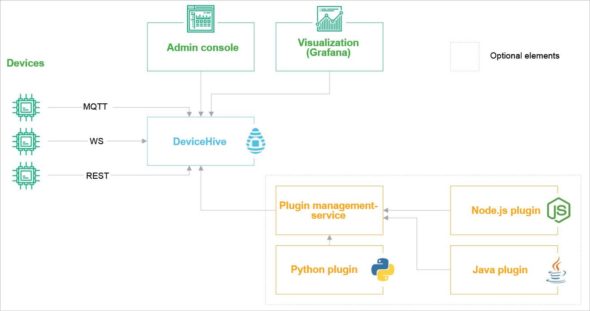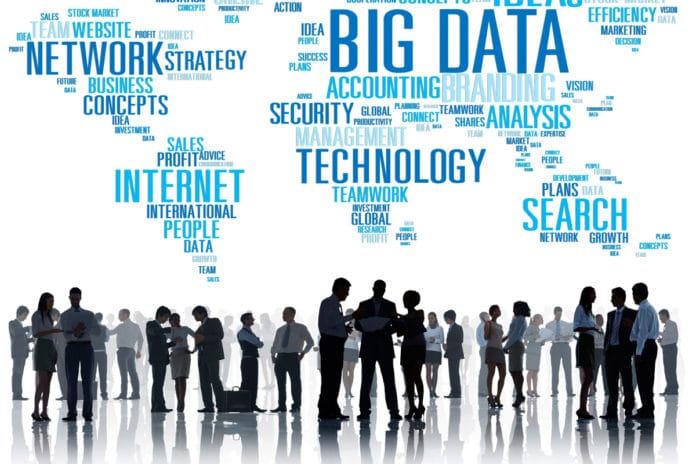The Internet of Things (IoT) along with Big Data is captivating the digital world. A horizontal IoT platform encourages a large number of clients to work with a typical framework, thus enabling rapid growth and innovation in businesses. By making the gateway and cloud resources have open functionality, innovators can concentrate their efforts on creating devices and services.
The backbone of IoT is connectivity; hence, an IoT platform can be as simple as software infrastructure that handles connectivity between physical objects. Due to a rise in the number of connected endpoints and smart devices, the IoT market is placing a huge demand on platforms that provide real-time intelligence, machine-to-machine interaction, cross-industry applications, multi-vendor interoperability and end-to-end security. Hence, the platform may be furnished with entities such as artificial intelligence (AI), machine learning and augmented reality. IoT basically consists of the following building blocks.
- Connectivity: All IoT platforms have a connectivity layer that provides a duct for data acquisition, remote access and control.
- Device management: Provisioning tasks, device registry, device identification, device modelling, remote administration, software updating, authentication of cloud/backends, centralised log collection and management, fault tolerance, troubleshooting, diagnostics and remote reboot, are all tasks that are handled by the device management module.
- Data management: The data management block refers to the expansion, execution and administration of architectures, software and disciplines that control, defend, deliver and improve the value of data and information assets.
- Application enablement: Application enablement provides action management to expound rules, and activates the automation of tasks and services.
- Cloud back-end: Cloud back-end has the ability to handle extensive amounts of data and is cost-effective in comparison with on-premise infrastructures. Cloud computing is deemed an essential part of commercial IoT.
- Security: We need to provide lots of security, trust, privacy and identity management across endpoint devices, the network and the cloud in IoT platforms. This is performed by the Security Block.
Types of IoT platforms
IoT platforms can be categorised into different genres based on the unique types of services provided to end users. Platforms for smart wearables and home automation aim at the consumer market, and on unidirectional, data-to-cloud connectivity. On the other hand, Industrial IoT (IIoT) customers from sectors such as military, manufacturing, energy, automotive, agriculture, aerospace and banking are concerned with embedded software, tailored applications, device management, data management, interoperability, security, reliability responsiveness and high frequency bi-directional connectivity, etc.
Commercial IoT platforms are classified into five sections.
(i) End-to-end IoT platforms: These are full-stack platforms performing all services, including connectivity, protocol interoperability, data-structure interoperability, device management, device firmware/software upgrade management, rules engine, actions engine, ticketing management, data visualisation, analytics, multiple applications and accounts, applications templates, applications reuse and duplication, user management, dashboard building and customisation, reports, external interfaces, security, and data storage.
(ii) Connectivity management platforms: These are elementary IoT platforms that offer solutions for connectivity orchestration, connection management and provisioning of communication services for connected IoT devices.
(iii) Cloud storage platforms: Cloud based IoT platforms are the measurable enterprise grade back-end for data management of IoT applications.
(iv) Device management platforms: These offer device provisioning, remote administration, software updation, firmware upgrades, security patching, remote control of devices, monitoring and reporting about specific metrics associated with IoT assets.
(v) Analytics platforms: Analytics infrastructure runs analytical applications, Big Data processing, contextual mining and machine learning algorithms. Analytics platforms provide statistical and optimisation tools to extract valuable information from structured and unstructured data.
Here is a list of a few popular IoT platforms:
- Amazon AWS IoT
- Google Cloud IoT
- Microsoft Azure IoT
- Oracle IoT Cloud
- IBM Watson IoT
Open standards and a horizontal architecture
Developing open guidelines enables a horizontal architecture for IoT arrangement suppliers and gadget providers to expand on. A standard, IoT industrywide design aids in similarity and start-to-finish coordination since arrangement suppliers, IT associations and gadget makers can anticipate regular prerequisites when creating and actualising arrangements.
Horizontal architecture provides open connectivity, improved security, scalability and flexibility. It provides end-to-end integration, more solutions (i.e., normalisation, analytics and streaming), better privacy and security, higher quality and lower cost. IT organisations, in particular, are at the heart of enterprise IoT implementations and can help lead the transition to standards-based horizontal architecture.
Different horizontal platforms
Canopy
Canopy simplifies the IoT cloud by acting as a cloud relay between IoT devices and applications. It enables rapid development of IoT solutions for consumer, commercial and industrial markets. Canopy is a collection of software tools and libraries that simplify the development of cloud-enabled products. By ‘cloud-enabled product’, we mean any physical device with a connection to the Internet that can be monitored and/or controlled over the Web. Such products may include consumer appliances, industrial equipment and other IoT devices. A cloud-enabled product needs software to run in several places — on the device, in the cloud and within client-side applications. Canopy contains sub-projects for each of these:
- Canopy Embedded Development Kit (EDK) software runs on the device.
- Canopy Cloud Service (CCS) software runs on the server-side.
- Canopy Application Development Kit (ADK) software runs within an application — for example, on a smartphone or in a Web browser.
Chimera IoT
Chimera IoT provides real value to the world through IoT using anonymised data, crowd sourced remediation, and sophisticated rules based analytics integrated with AI and validated through a human feedback loop. Chimera IoT uses six technology products and services including HTML5, Google Analytics and Google Fonts. The six technologies it uses for its website include Amazon, Google and Sectigo SSL.
DeviceHive
DeviceHive is free open source software that helps in smart gadgets communication and its management. It comprises a communications layer and control software with multi-platform libraries, which allow users to improve smart energy, robotisation, remote sensing, remote control, telemetry, and more. DeviceHive also provides REST, Web socket APIs by default plus MQTT API as an extra plugin. All communication is performed by means of JSON messages.

Nimbits
Nimbits is a hybrid cloud server. This horizontal platform is built on constrained embedded systems by suggesting IoT related services. It can run on Amazon EC2, Google App Engine, Ubuntu Linux KVM based virtual machine and also Jetty (i.e., J2EE Web server) based frameworks. Nimbits adopts open data table services such as Google Data Table Format to use in graphing, and includes them in spreadsheets and also third party analytics tools.
Open Source Internet of Things (OSIOT)
Open Source Internet of Things (OS-IoT) is a free open source software library that facilitates the advancement of IoT gadgets by having an interface with an open, interoperable ecosystem.
The OSIoT library gives device-side (for example Application Entity in oneM2M terminology) support for fundamental oneM2M defined functions. The library offers help for the oneM2M network, and protocol functions permit app developers to collaborate with the system over a resource-oriented API.
prpl Foundation
The prpl Foundation is an open source platform. It is a network driven, community-oriented and non-benefit establishment that endeavours to enable the security and interoperability of embedded devices.
RabbitMQ
RabbitMQ is the most widely used open source message broker. It is lightweight and easy to send on-premise and in the cloud. It can meet high-scale, high-accessibility necessities by deploying in distributed and federated configurations.
SiteWhere
SiteWhere is an industrial strength open source application enabled platform for the Internet of Things. It delivers a multi-tenant microservice based infrastructure, which has the key features required for IoT applications to be built and deployed.
Webinos
Webinos is an application platform that is Web based. It enables a developer to approach native-like competence by means of JavaScript APIs. In addition, it features a set of interoperable protocols that can permit a device to access and use the services of another device remotely.
Yaler
Yaler is a relay service that is simple, open and scalable. It entitles secure exterior access to Internet-connected embedded frameworks and IoT gadgets that are beyond a router or a firewall system.
Connectivity issues can be triggered by firewalls and Network Address Translators (NATs) when installing embedded systems and products based on IoT in the real world. The horizontal approach can enable rapid growth and innovation in businesses by allowing multiple service providers to work on a single platform. However, it still has to acquire significant traction.
















































































